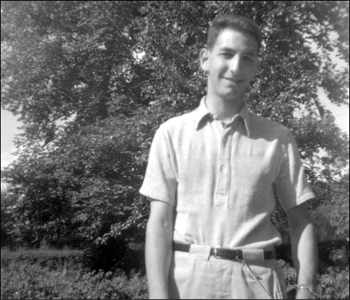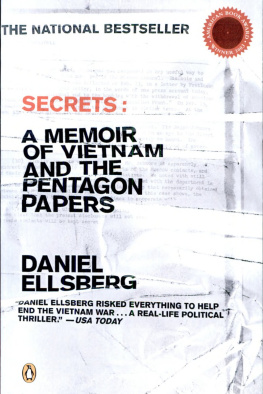
Steve Sheinkin is the award-winning author of fast-paced, cinematic histories for young readers. His work is widely acclaimed. The Port Chicago 50: Disaster, Mutiny, and the Fight for Civil Rights received the 2014 Boston Globe-Horn Book Award for Nonfiction and was a National Book Award finalist. The Notorious Benedict Arnold won the YALSA Award for Excellence in Nonfiction for Young Adults and the Boston Globe/Horn Book Award for nonfiction. His exploration of the atomic bomb, Bomb: The Race to Build-and Steal-The Worlds Most Dangerous Weapon was a Newbery Honor Book, National Book Award finalist, and winner of the Sibert Award as well as the YALSA Award for Excellence in Nonfiction for Young Adults. Sheinkins most recent work, Most Dangerous: Daniel Ellsberg and the Secret History of the Vietnam War , delves into the political intrigue of the Pentagon Papers. He lives in Saratoga Springs, NY. You can sign up for email updates here.

Many thanks to Daniel Ellsberg for taking the time to talk with me several times during the research and writing of this book. Ellsberg has written extensively about his life and granted hundreds of interviews, but our conversations produced a handful of details and clarifications that I would not have wanted to do without. Thanks also to Patricia Ellsberg, Robert Ellsberg, and Randy Kehler for answering questions and sharing recollections.
Rick Goldsmith, co-director and producer of the documentary The Most Dangerous Man in America , helped me get in touch with Ellsbergand made a must-see film on this story, which was a big boost to my research. Thanks to Sarah Pirtle for putting me in touch with Randy Kehler; and to Andy Lanset, director of the archives at New York Public Radio, for helping me find recordings of Patricia Marxs radio interviews; and to the staff of the Library of Congress for making available the Neil Sheehan Papers. Thanks again to the Saratoga Springs Public Library, for the endless supply of books and a quiet place to read them.
As she has been on past projects, Deirdre Langeland was as much a collaborator as an editor on this book. We went back and forth on everything from big structural issues to individual word choices, and as always she encouraged (forced) me to redo the opening about ten times. Thank you for that, really. Thanks as always to Anne Diebel for her amazing design work, and to Claire Dorsett for finding some mighty obscure photos and guiding us down the homestretch. Thanks also to Simon Boughton and everyone at Roaring Brook/Macmillan for backing this book idea, and to Susan Cohen and the Writers House team for making it all happen.
Im running out of ways to explain how important my wife, Rachel, is to this whole process, but heres one specific example. Long before there was anything to read, she helped settle many of the toughest questions about what to put in and what to cut. When she says, You gotta keep that, her word is final. Thank you, Rachel.
ALSO BY STEVE SHEINKIN
King George: What Was His Problem?
Two Miserable Presidents
Which Way to the Wild West?
The Notorious Benedict Arnold: A True Story of Adventure, Heroism & Treachery
Bomb: The Race to Buildand Stealthe Worlds Most Dangerous Weapon
The Port Chicago 50: Disaster, Mutiny, and the Fight for Civil Rights
W HAT COULD DANIEL ELLSBERG possibly have done to provoke such wrathto be seen as such a threat? The story begins twenty-six years earlier, as World War II came to an end and the Cold War began. Ellsberg was just starting ninth grade at a prep school near Detroit, Michigan.
He did not, at that time, appear particularly dangerous.
Kind of a nerd, is how one classmate described him.
Very intense, another recalled. Very studious and very interested in a lot of things.
A scrawny teen with dark curly hair, Dan was shy and quiet and had the unusual habit of walking around campus in a double-breasted suit, carrying his books and papers in a black briefcase. To classmates, he seemed obsessed with absorbing information and new ideas. But Dan did make an effort to branch out, landing the role of a wisecracking detective in the school play. He joined the bowling and rifle clubs. He gave soccer a try.

Daniel Ellsberg, age 16
I was terrible at soccer, he recalled.
Like many of his peers, Ellsberg was riveted by the rise of the Cold War. The global rivalry between the United States and the Soviet Union intensified quickly during Ellsbergs high school years, as Soviet ruler Joseph Stalin installed communist dictatorships in the countries of Eastern Europe, violently crushing calls for freedom in any land under his control. Ellsberg admired President Harry Trumans responsea commitment to supporting democracies and containing Soviet influence from spreading further.
I had become, Ellsberg later said, along with many other Americans, a cold warrior. In 1949 the Soviets tested their first atomic bomb, using plans stolen by spies from American labs. That same year Communists took power in China, the worlds most populous nation. Then, with Soviet and Chinese backing, communist North Korea invaded democratic South Korea in 1950. In the Korean War, U.S. forces helped push back the invasion, but at a cost of more than thirty-six thousand American lives. The Cold War was clearly going to be a long and bitter fight. Daniel Ellsberg wanted in.
After graduating third in his class from Harvard University, Ellsberg stunned friends and professors alike by applying for officers training with the Marine Corps. I didnt seem the type, he later conceded. My interests were almost entirely intellectual, and I wasnt any kind of athlete. But those recruiting postersthe ones asking men if they were tough enough to be a Marinecalled to him.

Marine Lieutenant Daniel Ellsberg, 1954
Ellsberg willed his way through a training course filled with jocks and tough guys, and he served with pride as a marine lieutenant. He then returned to Harvard and earned his PhD in economics. Questions of risk and decision making particularly intrigued him. To act reasonably, one must judge actions by their consequences, Ellsberg wrote in his doctoral thesis. But what if their consequences are uncertain?
How should one act when consequences are uncertain? That question would become a major theme in Ellsbergs life.
* * *
In the summer of 1964, Daniel Ellsberg was thirty-three, lean and fit, with blue eyes and brown hair cut short. As an analyst for the Rand Corporation, a think tank focused on military and international issues, he had been granted permission to conduct research at the Pentagon, home of the United States Department of Defense. He spent his days in a borrowed office, working on a study of recent international crises that he hoped would be useful to government policymakers.
One day in mid-July, he was at his desk, reading and taking notes, when Assistant Secretary of Defense John McNaughton dropped by. McNaughton knew Ellsbergs reputation as one of the brightest young thinkers in the field of crisis decision making. He wanted to discuss a trouble spot of increasing concern to the United States: a mountainous, heavily forested country winding more than a thousand miles along the coast of Southeast Asia. He wanted to discuss Vietnam.
Next page









